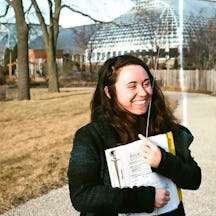How do you avoid catching the plague? Smoke constantly. Carry a sponge soaked in vinegar. Hang oranges studded with cloves around your house. This was the best medical advice available circa 1665, as the Great Plague ravaged London. The miasma theory of contagious disease held that sickness spread through unpleasant aromas. A whiff of ‘bad air’ could kill you – and the right fragrance just might save your life.
Deadly stinks and life-saving aromas in plague-stricken London
Words by Amelia Soth
- In pictures

When the plague struck, doctors fled the city in droves. The ones who stayed behind – the poorest or most altruistic – insulated themselves from miasma with these protective suits. The robe was slicked with scented wax, and the eerie beaked mask was stuffed with herbs to purify the pestilential air.

Hoping to drive away the poisonous vapours, the Lord Mayor ordered huge bonfires to blaze in the streets for three days and three nights straight. Anything that could be burned was fed into the flames. The stench of decay was replaced with black choking smoke – probably not much of an improvement.

Indoors, people burned sweet-smelling herbs in fumigation torches. Fumigation was a common means of disinfecting the homes of the sick, which were sealed up, often with the sufferers trapped inside. Professional fumigators were notorious for robbing plague patients as they lay on their deathbeds.

According to legend, one of the best-known plague remedies was invented by a gang of burglars, who used it to steal from infested homes without fear of infection. Supposedly, when they were finally caught, they exchanged the recipe for the ‘four thieves vinegar’ for their freedom. Whether or not the tale is true, vinegar was a key component of the anti-miasma arsenal. This silver skull, for instance, once held a vinegar-soaked sponge for its owner to sniff while walking the city streets.

Exotic spices, imported from the East, were a luxurious option for plague protection. Those who could afford it scattered cloves, cinnamon and fennel over their windowsills to scent the air as it wafted in. Orange studded with cloves, which we now associate with Christmas, originated as plague preventatives.

The wealthy also employed perfumers to disinfect homes stricken with pestilential air. The cleansing process was an elaborate ritual that involved both sweet scents and harsh reeks – vinegar, industrial waste and even urine. It was commonly believed that a strong stench could overpower a dangerous miasma, leading some people to seek out tanneries and cesspits. One physician even recommended sharing your home with a stinky goat.

Speaking of reeks, here’s some health advice from 1665: take up smoking! In 1665, students at Eton were required to take a daily puff of tobacco. Refuse the daily pipe, and you’d get a whipping.
Although the plague receded after 1665, the miasma theory continued to hold sway into the early 1800s, when England was hit with a devastating cholera epidemic. The ‘cholera preventive costume’ shown in this cartoon includes strong-smelling elements like tea, juniper and herbs.

Public health reformers and physicians charted the spread of disease with medical topographies like this one, which shows ‘cholera mist’ emanating from afflicted areas of Bethnal Green. In this era, concern about miasmas drove a wave of sanitation reforms that raised the standard of living for even the poorest members of society.

Finally, a fascinating footnote in the history of powerful smells: As we’ve seen, miasma theory considered odours to be material substances that could have a powerful impact on the body, whether harmful or helpful. Eva Vliegen took this to its logical extent, by claiming to have survived for over ten years on just the sweet fragrance of flowers.
About the author
Amelia Soth
Amelia lives in Chicago and writes the column ‘Cabinet of Curiosities’ for JSTOR Daily.

